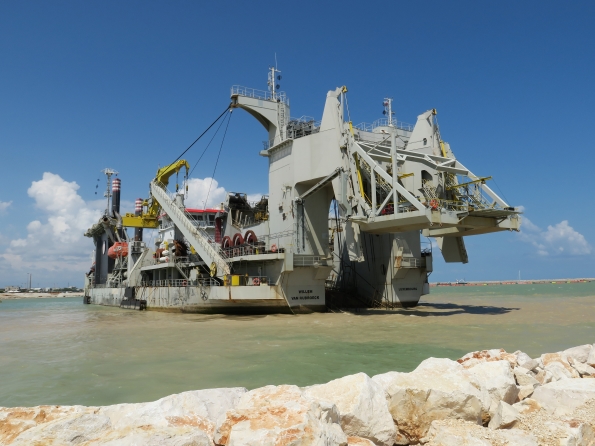Jan De Nul faces challenging dredging operation in Italy
Not a member yet? Learn about the benefits of membership

Photo Credit: Bert Visser
Jan De Nul Group’s newest and largest cutter suction dredger (CSD), Willem Van Rubroeck, was sent to Italy in late May to be deployed on a challenging project that has been long in the making in the port of Bari.
Capital of the Italian region Puglia, Bari is an important economic centre in southern Italy.
Located on the Adriatic coast, its port constitutes a main link with many Balkan countries.
There are several ferry and roll-on-off (RoRo) routes to and from Croatia, Montenegro, Albania, and Greece, each of which is served on a daily basis.
The busy port also has regular calls from cruise ships and handles a variety of cargo vessels.
At present, all commercial port activities are concentrated in an area adjacent to the old city, known as Bari Vecchia, a famous tourist attraction. It is highly frequented by both Italian as well as international travelers.
To relieve the pressure on the existing port facilities, as well as make the area between the port and Bari Vecchia more attractive from a tourist point of view, the Italian government, as port owner, has had a long-cherished wish to transfer a large part of the commercial port activities westward to a new area and away from the old city.
Dredging works are being subcontracted by the joint venture to Jan De Nul Group. The latter has deployed the CSD Willem Van Rubroeck, which with a total installed power of 41,346 kW is one of the most powerful dredgers in the world. This marks a milestone for a project that has overcome challenging circumstances including technical difficulties that impacted the allocated budget. The technical challenges were the result of the presence of very hard and resistant limestone commonly found in the Puglia region; Calcare di Bari and Calcarenite di Gravina.
Up until about two decades ago, the excavation of this type of material would require drilling and blasting, which is not only costly, but is also not accepted due to the proximity of buildings and infrastructure.
The port’s plans were made possible when the previous cutter suction type dredger with a power of 23,000 kW was upscaled in 2020 to 41,000 kW. This new generation dredger will allow all material present at the site to be dredged.
In 2012, the Ministry's interregional agency (Provveditorato Interregionale) for the regions Campania, Puglia, Molise e Basilicata, awarded a contract to the joint venture Piemme Scarl composed of the Italian companies Fincosit srl and Nuova Coedmar, with Fincosit as the leading partner.
This contract covered the dredging of limestone near the existing Pizzoli pier to a depth of 12 meters, representing approx. 600,000 m3 of material, and the reclamation of the area known as Marisabella area, to serve as future handling areas for goods, trucks, and cars.
Furthermore new quay walls are to be constructed, score protection has to be installed and the Marisabella reclamation has to be profiled and paved.
And now, Jan De Nul Group is taking on the challenge of the dredging works. Analysis had shown that the limestone to be dredged had a compressive strength of 30 MPa and above. In some cases, it even reached 70 MPa, comparable to the strongest concrete types.
Another parameter that indicates how difficult rock type material is to dredge is the Rock Quality Designation (RQD), which is expressed in percentage and indicates the degree of fracture of the rock. The higher the percentage, the more solid and massive the rock is, the lower it is, the more it has been subject to wear and the more it is fractured. Ultimately, the higher the RQD, the more difficult it is to break material and dredge.
In Bari, approximately a tenth of the material to be excavated by the Willem Van Rubroeck had a RQD of between 70% and 90%. While around 2% of the material had a RQD of 100%, making for a challenging project dealing with rock that has enormous size and density.
To deal with this kind of material, the Willem Van Rubroeck had two types of ESCO heavy-duty cutter systems at its disposal. The first one is the 68D type, which until recently was ESCO's largest cutterhead; this type has been designed for heavy-duty rock excavation by large CSDs.
Recently, ESCO developed a new type of cutterhead,the ESCO 9G, that is specifically meant to be used on the latest generation of ultra-large CSDs with a total installed power of over 40,000 kW.
With these cutter systems and its enormous cutter power of 8,500 kW, the Willem Van Rubroeck, despite the challenging circumstances, has succeeded in getting all the 600,000 m3 of material out and pumped into the Marisabella reclamation in just two months.
On 23 July 2022, the dredging works were completed and Jan De Nul's project team could look back on a very successful operation.
The Willem Van Rubroeck will now be prepared for its next assignment and in the meantime, the staff of main contractor Fincosit can concentrate on the remaining work to be carried out on the Bari port project.
While the advice given in this editorial content has been developed using the best information available, it is intended purely as guidance to be used at the user’s own risk. No responsibility is accepted by CEDA or by the Intent Communications Ltd or by any person, firm, corporation or organisation who or which has been in any way concerned with the furnishing of information or data, the compilation, publication or any translation, supply or sale of this Guidance for the accuracy of any information or advice given herein or for any omission herefrom or from any consequences whatsoever resulting directly or indirectly from compliance with or adoption of guidance contained therein even if caused by a failure to exercise reasonable care.